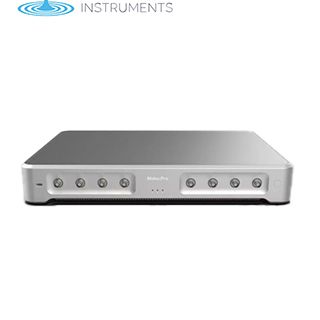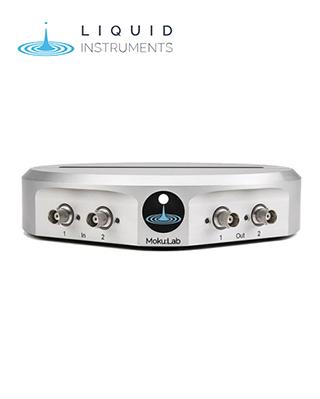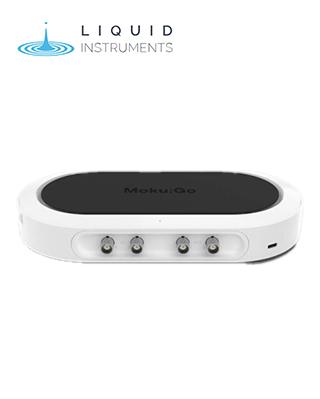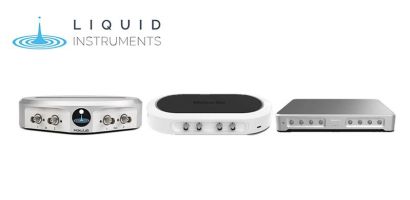Moku:Pro 為您的研究提供最有力的平台
|
靈活性不打折扣 Moku:Pro是新一代可程控軟體來定義的儀器。具備提供性能和靈活性。強大的Xilinx Ultrascale+ FPGA與高頻寬類比前端以及强大的網路和存儲功能相結合。 |
|
|
|
|
|
|
4 個類比輸入 |
4 個類比輸出 |
高速固態硬碟 |
輸入頻寬 |
|
|
|
|
|
|
時鐘穩定度 |
輸入到輸出的延遲 |
新穎的通訊方式 |
啟用的FPGA |
|
可完全透由軟體操控 Moku:Pro是Moku軟體自定義平台套件中最先進的系統。利用FPGA與高品質模擬前端相結合的力量,Moku:Pro能夠在一個硬體平台上承載 多個儀器,而不犧牲規格或精度。 這種測試設備的方法使其有可能輕鬆地擴展和擴大研究的範圍。 有了Moku:Pro,研究人員和工程師更能夠有了適合工作的工具。 |
 |
|
|
|
混合型ADC 在測試和測量中,靈活性通常要求在性能上有所取捨。 我們通過在專利混合方案中使用來自5 GSa/s、10位ADC和10 MSa/s、18位ADC的 信號來克服這些折衷,以提供10 Hz至600 MHz的低雜訊和高動態範圍。 這是通過一個由平衡高通和低通濾波器組成的數位交換網路,該網路實現了雙ADC 數據流的即時混合。 |
|
|
多儀器功能 儀器通過一個低延遲、即時的20Gb/s信號路徑連接。與類比輸入、類比輸出和相鄰 功能項目的連接可在運行時配置,以獲得即時滿足。這會讓您的Moku:Pro呈現出更 加強大可應用性。 |
 |
|
 |
FPGA訪問 高級用戶將能夠訪問 Moku:Pro 的 FPGA,通過寫自己的 VHDL 代碼來實現自定義 數位信號處理。這種基於雲的工具可直接從瀏覽器訪問,您開發、編譯和開發自定義 操作到您 的Moku:Pro,而無需下載任何程式軟體。 您的定制儀器將可以訪問標準的Moku:Pro資源,如類比輸入和輸出。自定義儀器也 可以部署在多儀器模式下的單個儀器插槽上。您可以將您的創作插入LI的儀器套件 中,以提供高品質的用戶界面來幫助您的測試。編程和編譯是用工業標準的VHDL代 碼完成的,使您能夠與第三方的高級工具一起工作。 Moku:Pro的編譯工具為早期階 段的原型設計提供了一個高效能、易用的替代方案,可以與FPGA開發板一起工作。 |
類比輸入
- 頻道 4
- 頻寬 600 MHz (up to 2 channels). 300 MHz (up to 4 channels)
- 取樣率 5 GSa/s (1 channel), 1.25 GSa/s (4 channels)
- 解析度 10-bit and 18-bit ADCs with automatic blending
- 最大電壓範圍 40 Vpp
- 輸入阻抗 50 Ω or 1 MΩ
- 輸入耦合 AC or DC
- AC耦合角 16 kHz into 50 Ω, 1.6 Hz into 1 MΩ
- 輸入電壓雜訊 20 nV√Hz at 100 Hz
- 輸入參考雜訊 500 μV RMS
類比輸出
- 通道 4
- 頻寬 500 MHz (± 1 V), 100 MHz (± 5 V)
- 取樣率 1.25 GSa/s
- 解析度 16 bit
- 電壓範圍 10 Vpp into 50 Ω
- 輸出阻抗 50 Ω
- 輸出耦合 DC
- 連接器 BNC
功能與附件
- 用戶界面 iPadOS App
- 程式設計環境 Python
MATLAB
- 其他介面 Ethernet
USB-C
10 MHz reference clock in and out
Flexibility without compromise
Moku:Pro is the next generation of software-defined instrumentation, delivering both performance and flexibility.
A powerful Xilinx Ultrascale+ FPGA is coupled with a high-bandwidth analog front-end and robust networking and storage.
Moku:Pro’s suite of software-defined instruments supports high-speed data acquisition, processing and visualization,
waveform generation, and real-time control applications.
Our proprietary hybrid front-end design performs frequency-dependent signal blending from multiple ADCs,
delivering exceptional noise performance from acoustic to radio frequencies.
|
|
|
|
|
|
4 Analog Inputs |
4 Analog Outputs |
High-Speed Onboard Storage |
Noise Performance |
|
|
|
|
|
|
Clock Stability |
Input to Output Latency |
Modern Connectivity |
FPGA Enabled |
|
Software-enabled hardware Moku:Pro is the most advanced system from the Moku suite of softwaredefined instrument platforms. Harnessing the power of the FPGA combinedwith a high-quality analog front-end, Moku:Pro is able to host multipleinstruments on a single hardware platform without sacrificing specs orprecision. This approach to test equipment makes it possible to scale andexpand the scope of research easily. With Moku:Pro, researchers andengineers already have the right tool for the job. |
 |
|
|
|
Blended ADCs In test and measurement, flexibility has typically demanded tradeoffs inperformance. We overcome these tradeoffs by using signals from a 5 GSa/s,10-bit ADC and a 10 MSa/s, 18-bit ADC in a patented blending scheme todeliver a low noise floor and high dynamic range from 10 Hz to 600 MHz.This is achieved through a digital crossover network consisting of balancedhigh- and low-pass filters that implement real-time blending of the dual ADCdata streams. |
|
|
Coming Soon: Multi-Instrument Capability This fall, users will be able to run multiple instruments to simultaneously on asingle Moku:Pro. You will be able to place instruments in up to four virtual“slots”, dynamically adding or removing Moku:Pro instruments to any ofthe four slots. For example, you can add an oscilloscope to slot 1, a spectrumanalyzer to slot 2, deploy a PID controller in slot 3, all while maintainingphase continuity on a waveform generator running in slot 4. Each slot hasdedicated access to the analog inputs and outputs, allowing you to run anentire suite of instruments with just one device.Instruments running in this mode can be chained together to instantly buildsophisticated signal-processing pipelines. Instruments are connected by alow-latency, real-time 20 Gb/s signal path. Connections to the analog inputs,analog outputs, and adjacent instruments are run-time configurable forinstant gratification. Your Moku:Pro is now even more powerful. |
 |
|
 |
Coming Soon: FPGA access Advanced users will be able to access Moku:Pro’s FPGA to implement custom digital signal processing by writing their own VHDL code. This cloud- based tool is accessed directly from a browser, allowing you to develop, compile and deploy custom algorithms to your Moku:Pro without a single software download. Your custom instruments will have access to standard Moku:Pro resources, like analog inputs and outputs. Custom instruments can also be deployed on individual instrument slots in multi-instrument mode. You can plug your creation into LI’s suite of instruments to provide a high-quality user interface and aid debugging. Programming and compiling are done with industry standard VHDL code, allowing you to work with high-level tools from third parties. Moku:Pro’s compiling tool provides an efficient, easy-to- use alternative to working with FPGA dev boards for early stage prototyping. |
Analog inputs
- Channels:4
- Bandwidth:600 MHz (up to 2 channels). 300 MHz (up to 4 channels)
- Sampling rate:5 GSa/s (1 channel), 1.25 GSa/s (4 channels)
- Resolution:10-bit and 18-bit ADCs with automatic blending
- Maximum voltage range:40 Vpp
- Input Impedance:50 Ω or 1 MΩ
- Input coupling:AC or DC
- AC coupling corner:16 kHz into 50 Ω, 1.6 Hz into 1 MΩ
- Input voltage noise:30 nV√Hz at 100 Hz
- Input referred noise:500 μV RMS
Analog outputs
- Channels:4
- Bandwidth:500 MHz (± 1 V), 100 MHz (± 5 V)
- Sampling rate:1.25 GSa/s
- Resolution:16-bit
- Voltage Range:10 Vpp into 50 Ω
- Output impedance:50 Ω
- Output coupling:DC
- Connector:BNC
Features & Accessories
- User Interface:iPadOS App
- Programming Environment:Python,MATLAB
- Additional Ports:Ethernet,USB-C,10 MHz reference clock in and out















